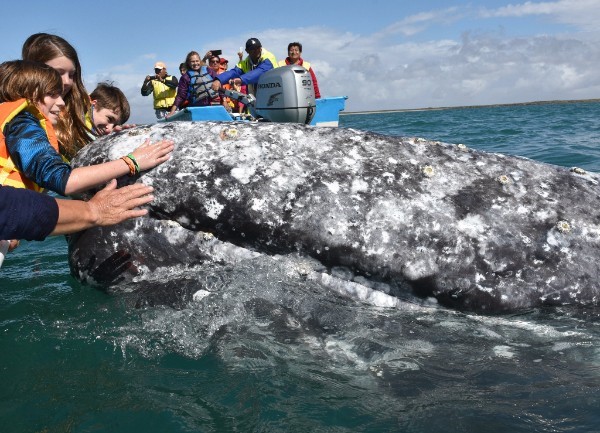
The Mexican state of Baja California Sur is perfect for visitors looking to soak up the sun, sand, and sea. But explore beyond the scenic shores and you’ll find yourself in one of the most biologically diverse marine ecosystems on the planet. Living up to its nickname as the “Aquarium of the World”, the Sea of Cortez features over 875 species of fish and mammals including dolphins, sea lions, whales, and the endangered whale shark. During the winter, three whale species (and two pseudo-whales) migrate to the Sea of Cortez. Because of this, whale watching is one of the most popular activities among visitors to La Paz.
Whale Species and Seasons:
- Peaceful grey whales can be found in the Pacific Ocean in Magdalena Bay beginning in mid-December and through until March. They are curious creatures, and have been known to come quite close to boats. Grey whale calves are most commonly born in shallower waters in Mexico which provides them with optimal conditions. These young whales can be especially inquisitive, sometimes blowing bubbles and nudging boats.
- Playful humpback whales are considered the most acrobatic of all species. Visitors can see them repeatedly breach the water around La Paz, Todos Santos, and Los Cabos from February to June.
- Gentle blue whales, the largest of all mammals, are found in the warm waters of Loreto (a four hour drive from La Paz) from March to July. These beautiful behemoths often swim solo but can be heard singing from the depths while looking for a mate.
- Whale sharks, although technically not whales, are a gentle shark species and more akin to whales than sharks. They can be seen in the waters around La Paz from October to March when many of La Paz’s accredited operators offer snorkeling to get up close and personal with these friendly fish.
- Pilot whales, a species of dolphin, can be distinguished from their cetacean cousins by their rounded nose. They are highly social and from March to May, they can be found in the Sea of Cortez.
Although each species has a different peak viewing seasons, as many as 300 whales can be present on any given day.
Dos and Don’ts:
- DO: Dress for the weather. Light layers and long sleeves will keep you protected from the sun and wind.
- DO: Let the whales determine how long they stay near the boat.
- DO: Research the whales you might see while on your trip. Learning about them in advance will enhance your experience.
- DON’T: Go out on the water alone or personally charter your own boat to go whale watching. Use accredited tour operators who adhere to a strict code of conduct and will offer you the best experience.
- DON’T: Forget your camera!
Fishing for more?
For more opportunities to learn about the whales that migrate through the La Paz area, a visit to the Museo de La Ballena (Whale Museum) is a must. Visitors to the recently opened museum are greeted by an impressive whale skeleton outside the main building. Inside, the museum offers guided tours to build a deeper understanding of the variety of species, and exhibitions including a complete orca skeleton suspended from the ceiling. The museum aims to teach visitors and locals alike about the natural history and biology of marine animals as well as sharing important research around environmental conservation. For more information, visit www.museodelaballena.org
INSIDER TIP: Visitors who are prone to or concerned about seasickness should opt for a morning whale watching tour and avoid consuming alcohol the night before.





